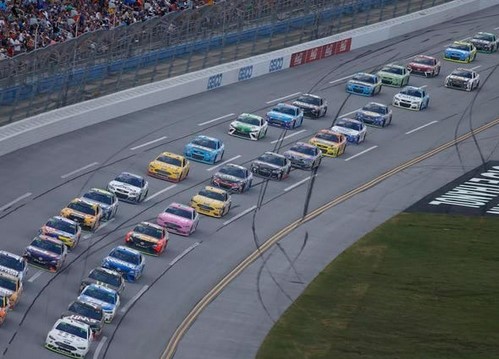
The Thrills of Racing in an Oval Track
Oval track racing is a high-speed motorsport that has captivated racing enthusiasts for decades. The adrenaline rush, the thunderous roars of engines, and the heart-pounding competition make it a favorite among fans and drivers alike. In this article, we’ll dive into the world of oval track racing, exploring its history, the mechanics of oval tracks, and the iconic Winchester Speedway.

The Allure of Oval Track Racing
Oval track racing is a unique motorsport characterized by its circular or oval-shaped tracks. These tracks can be made of various materials, including dirt, asphalt, or concrete. Oval racing is all about speed, precision, and strategy, and it’s a thrilling spectacle that has a dedicated following.
The Birth of Oval Racing
Oval track racing has deep roots in the early days of motorsports. The first oval tracks were often horse racing tracks repurposed for automobiles. As the sport grew in popularity, purpose-built oval tracks emerged, designed to accommodate the high speeds and unique dynamics of racing cars.
Types of Oval Tracks
Oval tracks come in various configurations, including:
- Short Tracks: Short oval tracks are typically under one mile in length. These tracks offer intense, close-quarters racing and are known for their exciting collisions and competitive racing.
- Intermediate Tracks: These tracks fall between one and two miles in length. They provide a balance between speed and strategy, with drivers needing to find the right groove for optimum performance.
- Super Speedways: Super speedways are tracks over two miles long, allowing for incredibly high speeds. These tracks are often used in elite racing series like NASCAR and IndyCar.
Racing on Oval Tracks: The Mechanics
Oval track racing is about more than just going in circles. It requires a deep understanding of vehicle dynamics, aerodynamics, and precise control. Here are some key elements of oval track racing:
- Drafting: Drivers use drafting to reduce air resistance by following closely behind the car in front. This technique allows for bursts of speed and is essential for overtaking competitors.
- Banking: Oval tracks are often banked, meaning they slope inward. Banking helps vehicles maintain traction and navigate the turns at high speeds.
- G-Forces: Drivers experience significant G-forces as they accelerate and turn on oval tracks. These forces test a driver’s physical endurance and mental focus.
- Pit Stops: Pit stops are critical for refueling, tire changes, and adjustments. Teams need to execute fast, efficient pit stops to stay competitive.
Winchester Speedway: A Legendary Oval Track
One of the most iconic oval tracks in the United States is Winchester Speedway. Located in Winchester, Indiana, this half-mile high-banked oval track has a storied history dating back to the early 20th century. Winchester Speedway garners recognition for its intense, action races and its distinctive high-banking turns that challenge even the best drivers.
Winchester 400: A Premier Racing Event
The Winchester 400 is a premier racing event held annually at Winchester Speedway. This 400-lap super late model race is one of the most prestigious short track events in the country. Drivers from various racing backgrounds converge on Winchester to test their skills and claim victory in this grueling race.
Challenges of Racing at Winchester Speedway
Winchester Speedway presents unique challenges for drivers. The high banking, combined with the short track length, demands a delicate balance of speed and control. Racing at Winchester requires precise maneuvering, and even a slight misjudgment can result in a dramatic spin or collision.
The Winchester Speedway Experience
For fans, Winchester Speedway offers an unforgettable experience. The roar of engines, the scent of burnt rubber, and the palpable excitement in the air create a thrilling atmosphere. Spectators witness daring passes, dramatic crashes, and moments of victory that define oval track racing.
Safety Measures and Regulations
Safety is a paramount concern in oval track racing, and Winchester Speedway is no exception. Drivers are equipped with state-of-the-art safety gear, including helmets, fire-resistant suits, and multi-point harnesses. The tracks are equipped with barriers and safety walls to reduce the risk of injury in the event of a crash.
The Role of the Pit Crew
The pit crew plays a pivotal role in oval track racing. They are responsible for maintaining and repairing the race car during pit stops. The precision and speed of the pit crew can make the difference between winning and losing.
The Spirit of Competition
Oval track racing is a highly competitive sport. One in which split-second decisions and flawless execution mean victory. Drivers and their teams dedicate countless hours to fine-tuning their cars and strategies, seeking any advantage they can find.
Fan Engagement
Oval track racing has a passionate and dedicated fan base. Fans carry deep involvement in the sport, often forming allegiances to their favorite drivers and teams. The interaction between fans, drivers, and the racing community creates a unique camaraderie.
The Future of Oval Track Racing
Oval track racing continues to evolve and adapt to the changing times. Technological advancements in vehicle design and safety measures have made the sport safer and more competitive. The inclusion of electric vehicles and alternative energy sources is also a topic of discussion, pointing towards a sustainable future for oval racing.
Conclusion
Oval track racing is a thrilling motorsport that has left an indelible mark on the world of racing. From its humble beginnings to the grandeur of tracks like Winchester Speedway, oval racing represents a unique blend of speed, strategy, and sheer excitement. Whether you’re a driver, a pit crew member, or a devoted fan, oval track racing offers an unparalleled experience that celebrates the spirit of competition and the pursuit of victory.
